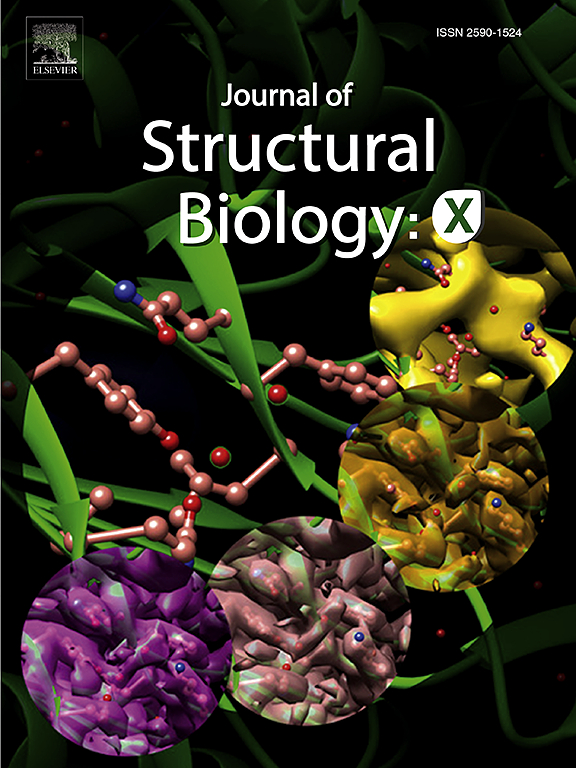改进对称错配大分子组装的低温电镜图谱:鞭毛马达的案例研究。
IF 2.7
3区 生物学
Q3 BIOCHEMISTRY & MOLECULAR BIOLOGY
引用次数: 0
摘要
低温电子显微镜仪器和样品制备的进步显著提高了收集生物分子结构高质量数据的能力。然而,在对称不匹配的结构中,实现与数据质量一致的分辨率仍然具有挑战性。作为一个案例研究,细菌鞭毛马达是细菌趋化性和毒力所必需的大型复合体。该马达包含一个较小的膜上环(MS-ring)和一个较大的细胞质环(C-ring)。当在大肠杆菌中表达时,这两个特征有33:34的对称不匹配。由于紧密的对称失配是最难解卷积的,这使得鞭毛马达成为一个很好的模型系统来评估对称失配的改进策略。我们比较了掩码细化、局部细化和粒子减法细化在相同数据上的性能。我们发现,在细化之前的粒子减法对于正确地反卷积较小的ms环的对称性是必不可少的。额外的处理导致ms环的最终分辨率为3.1 Å, c环的最终分辨率为3.0 Å,与过去的工作相比,ms环的分辨率提高了0.3 Å, c环的分辨率提高了1.0 Å。虽然粒子减法是相当完善的,但它很少应用于对称不匹配的问题,使本案例研究成为其在这种情况下的实用性的有价值的演示。本文章由计算机程序翻译,如有差异,请以英文原文为准。

Improving CryoEM maps of symmetry-mismatched macromolecular assemblies: A case study on the flagellar motor
Advances in cryo-electron microscopy instrumentation and sample preparation have significantly improved the ability to collect quality data for biomolecular structures. However, achieving resolutions consistent with data quality remains challenging in structures with symmetry mismatches. As a case study, the bacterial flagellar motor is a large complex essential for bacterial chemotaxis and virulence. This motor contains a smaller membrane-supramembrane ring (MS-ring) and a larger cytoplasmic ring (C-ring). These two features have a 33:34 symmetry mismatch when expressed in E. coli. Because close symmetry mismatches are the most difficult to deconvolute, this makes the flagellar motor an excellent model system to evaluate refinement strategies for symmetry mismatch. We compared the performance of masked refinement, local refinement, and particle subtracted refinement on the same data. We found that particle subtraction prior to refinement was critical for approaching the smaller MS-ring. Additional processing resulted in final resolutions of 3.1 Å for the MS-ring and 3.0 Å for the C-ring, which improves the resolution of the MS-ring by 0.3 Å and the resolution of the C-ring by 1.0 Å as compared to past work. Although particle subtraction is fairly well-established, it is rarely applied to problems of symmetry mismatch, making this case study a valuable demonstration of its utility in this context.
求助全文
通过发布文献求助,成功后即可免费获取论文全文。
去求助
来源期刊

Journal of structural biology
生物-生化与分子生物学
CiteScore
6.30
自引率
3.30%
发文量
88
审稿时长
65 days
期刊介绍:
Journal of Structural Biology (JSB) has an open access mirror journal, the Journal of Structural Biology: X (JSBX), sharing the same aims and scope, editorial team, submission system and rigorous peer review. Since both journals share the same editorial system, you may submit your manuscript via either journal homepage. You will be prompted during submission (and revision) to choose in which to publish your article. The editors and reviewers are not aware of the choice you made until the article has been published online. JSB and JSBX publish papers dealing with the structural analysis of living material at every level of organization by all methods that lead to an understanding of biological function in terms of molecular and supermolecular structure.
Techniques covered include:
• Light microscopy including confocal microscopy
• All types of electron microscopy
• X-ray diffraction
• Nuclear magnetic resonance
• Scanning force microscopy, scanning probe microscopy, and tunneling microscopy
• Digital image processing
• Computational insights into structure
 求助内容:
求助内容: 应助结果提醒方式:
应助结果提醒方式:


